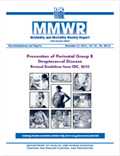Overview of 2010 Guidelines
2010 Guidelines for the Prevention of Perinatal Group B Streptococcal (GBS) Disease are available from CDC.
2010 Guidelines for the Prevention of Perinatal Group B Streptococcal (GBS) Disease

The foundations of prevention in 2010 remain unchanged from the 2002 guidelines:
- Pregnant women should undergo vaginal-rectal screening for GBS colonization at 35-37 weeks.
- Intrapartum antibiotic prophylaxis (IAP) is recommended for:
- Women who delivered a previous infant with GBS disease
- Women with GBS bacteriuria in the current pregnancy
- Women with a GBS-positive screening result in the current pregnancy
- Women with unknown GBS status who deliver at less than 37 weeks’ gestation, have an intrapartum temperature of 100.4°F or greater, or have rupture of membranes for 18 hours or longer.
- Penicillin remains the preferred agent with ampicillin an acceptable alternative.
New in the 2010 guidelines:
- There are expanded options for laboratory detection of GBS, including use of pigmented media and PCR assays.
- There is a revised colony count threshold for laboratories to report GBS in the urine of pregnant women.
- There are revised algorithms for GBS screening and use of IAP for women with threatened preterm delivery, including one algorithm for preterm labor and one for preterm premature rupture of membranes.
- Recommendations for IAP agents are presented in an algorithm format in an effort to promote use of the most appropriate antibiotic for penicillin-allergic women.
- A minor change has been made to penicillin dosing to facilitate implementation in facilities with different pre-packaged penicillin products.
- The neonatal management algorithm’s scope was expanded to apply to all newborns.
- It provides management recommendations that depend upon clinical appearance of the neonate and other risk factors such as maternal chorioamnionitis, adequacy of IAP if indicated for the mother, gestational age and duration of membrane rupture.
- Changes were made to the algorithm to reduce unnecessary evaluations in well appearing newborns at relatively low risk for early-onset GBS disease.
- Page last reviewed: May 23, 2016
- Page last updated: June 1, 2014
- Content source:




 ShareCompartir
ShareCompartir